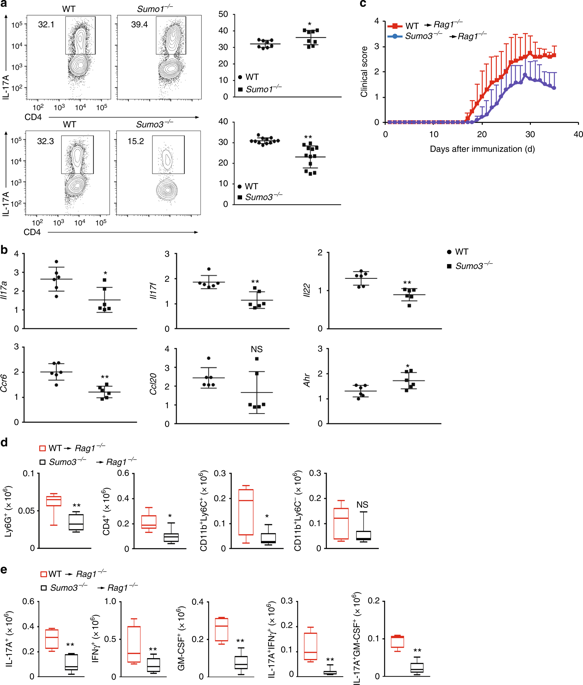当前位置:
X-MOL 学术
›
Nat. Commun.
›
论文详情
Our official English website, www.x-mol.net, welcomes your
feedback! (Note: you will need to create a separate account there.)
Sumoylation of RORγt regulates TH17 differentiation and thymocyte development.
Nature Communications ( IF 14.7 ) Pub Date : 2018-11-19 , DOI: 10.1038/s41467-018-07203-z Zhiheng He , Jing Zhang , Zhaofeng Huang , Qian Du , Ning Li , Qiang Zhang , Yuan Chen , Zuoming Sun
Nature Communications ( IF 14.7 ) Pub Date : 2018-11-19 , DOI: 10.1038/s41467-018-07203-z Zhiheng He , Jing Zhang , Zhaofeng Huang , Qian Du , Ning Li , Qiang Zhang , Yuan Chen , Zuoming Sun

|
RORγt controls the differentiation of TH17 cells, which are mediators of autoimmune conditions such as experimental autoimmune encephalomyelitis (EAE). RORγt also regulates thymocyte development and lymph node genesis. Here we show that the function of RORγt is regulated by its sumoylation. Loss of Sumo3, but not Sumo1, dampens TH17 differentiation and delays the progression of thymic CD8+ immature single-positive cells (ISPs). RORγt is SUMO3-modified by E3 ligase PIAS4 at lysine 31 (K31), and the mutation of K31 to arginine in mice prevents RORγt sumoylation, leading to impaired TH17 differentiation, resistance to TH17-mediated EAE, accumulation of thymic ISPs, and a lack of Peyer's patches. Mechanistically, sumoylation of RORγt-K31 recruits histone acetyltransferase KAT2A, which stabilizes the binding of SRC1 to enhance RORγt transcription factor activity. This study thus demonstrates that sumoylation is a critical mechanism for regulating RORγt function, and reveals new drug targets for preventing TH17-mediated autoimmunity.
中文翻译:

RORγt的糖基化调节TH17分化和胸腺细胞发育。
RORγt控制T H 17细胞的分化,T H 17细胞是自身免疫疾病(例如实验性自身免疫性脑脊髓炎(EAE))的介体。RORγt还调节胸腺细胞的发育和淋巴结的发生。在这里我们表明,RORγt的功能受其磺酰化作用调节。Sumo3而非Sumo1的丧失会抑制T H 17分化,并延迟胸腺CD8 +未成熟的单阳性细胞(ISP)的进程。RORγt在赖氨酸31(K31)处被E3连接酶PIAS4进行SUMO3修饰,小鼠中K31突变为精氨酸可阻止RORγt磺酰化,导致T H 17分化受损,对T H的抗性17介导的EAE,胸腺ISP积累和缺乏Peyer斑块。机械上,RORγt-K31的磺酰化募集组蛋白乙酰转移酶KAT2A,其稳定SRC1的结合以增强RORγt转录因子的活性。因此,这项研究表明,磺酰化是调节RORγt功能的关键机制,并揭示了预防T H 17介导的自身免疫的新药物靶标。
更新日期:2018-11-20
中文翻译:

RORγt的糖基化调节TH17分化和胸腺细胞发育。
RORγt控制T H 17细胞的分化,T H 17细胞是自身免疫疾病(例如实验性自身免疫性脑脊髓炎(EAE))的介体。RORγt还调节胸腺细胞的发育和淋巴结的发生。在这里我们表明,RORγt的功能受其磺酰化作用调节。Sumo3而非Sumo1的丧失会抑制T H 17分化,并延迟胸腺CD8 +未成熟的单阳性细胞(ISP)的进程。RORγt在赖氨酸31(K31)处被E3连接酶PIAS4进行SUMO3修饰,小鼠中K31突变为精氨酸可阻止RORγt磺酰化,导致T H 17分化受损,对T H的抗性17介导的EAE,胸腺ISP积累和缺乏Peyer斑块。机械上,RORγt-K31的磺酰化募集组蛋白乙酰转移酶KAT2A,其稳定SRC1的结合以增强RORγt转录因子的活性。因此,这项研究表明,磺酰化是调节RORγt功能的关键机制,并揭示了预防T H 17介导的自身免疫的新药物靶标。































 京公网安备 11010802027423号
京公网安备 11010802027423号